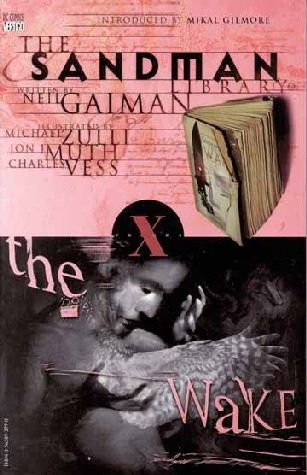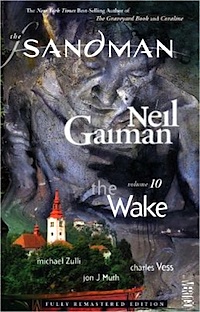The tenth and final collection of the original Neil Gaiman Sandman run, entitled The Wake, collects the four-part title story arc plus two other epilogues, respectively called “Exiles” and “The Tempest.” So it’s an epilogue and then another epilogue and a final epilogue. (If we leave out the follow-up stories by Gaiman written elsewhere.)
That’s a Peter Jackson Lord of the Ringsy kind of way to wrap it up, isn’t it?
But if you’ve sat through the extended editions of Lord of the Rings, you know that the endings upon endings feel properly paced and well-deserved. The same is true for Neil Gaiman and Sandman. Though it sometimes feels as if the entire second half of the series is about saying goodbye, “The Wake” and the two single-issue stories that follow are earned and resonant. And while they may not be strictly necessary—I think you could end your reading of Sandman with The Kindly Ones, drop the book, and strut away like a champ, though that would be weird and unnecessary unless your name is “Neil” and “Gaiman”—the stories collected in The Wake provide closure to the larger story and additional flavor to the Sandman mythology.
According to Gaiman’s acknowledgements at the end of this tenth volume, Roger Zelazny died as he was writing “The Wake” and some of the sentiments from the great author’s memorial found their way into Dream’s funeral service. So, in a way, it’s Gaiman’s chance to say goodbye to his most significant comic book character while also a chance to pay his respects to his storytelling forebears. Gaiman was never one to flinch from his influences, or to leave them unrecognized, as witnessed by his in-story tributes to the likes of G. K. Chesterton or Geoffrey Chaucer or William Shakespeare. The latter not only appeared in the award-winning “Midsummer Night’s Dream” story from Sandman #19, but he plays the central role in the final issue of Sandman with issue #75’s “The Tempest.”
When I first read the series, I would have ranked Sandman #19 above issue #75, with the former being a classic tale and the latter being a bit of a let down. Now, I would argue with my younger self. I’d champion the sophistication of the final issue—and its depiction of an end-of-career Shakespeare—against the relatively slight, but no doubt entertaining, charms of the “Midsummer” story. Like Shakespeare’s “The Tempest” there’s more to dig into with this later work than with the earlier stuff. Perhaps more unspoken, but no less implicit.
It’s something I’ve become accustomed to as I reread all of Gaiman’s Sandman. Though many of the stories still hold up as excellent examples of comic books, no matter the era, some of the issues I fondly remember were less exhilarating, more straightforward, than I had recalled. While most of the later issues, pretty much everything from The Kindly Ones to the end, which I remembered as being a bit of a mess and concluding the series without the mythic depth and ambition of the earlier issues, were actually more than charming. They were, in fact, filled with mysteries and allusions and, as I mentioned last time, the confidence of creators who were completely in control of the kind of story they wanted to tell and knew how to use the medium to best tell it.
I certainly appreciate the craftsmanship of the later issues more now than ever, but I also appreciate their message about farewells and goodbyes and the cycle of moving on.
That comes with age, no doubt, though Gaiman himself would only have been in his mid-30s when he wrote these reasonably profound, touching epilogue issues compiled in The Wake. Still, the series began when Gaiman was a mere lad in his late 20s, so it’s all relative.
The four issues of “The Wake” story arc provide pretty much what you’d expect, and maybe that’s another reason why I found them slightly disappointing when reading the original series as it was released. But as a wake for a dead god—or an Endless who can’t ever truly die but only transform into a new persona—it’s a substantial coda to the series. Michael Zulli draws the entirety of “The Wake,” and not only were his pages reproduced directly from his lush pencil drawings, but I believe it was the first time DC had used such a technique. It works well here, as Zulli is the kind of classic illustrator who benefits from the supple gray tones and haunting shadows evoked through the graphite.
The effect of following up the mostly-Marc-Hempel-drawn “Kindly Ones” arc with Michael Zulli is a bit like following The Clash with Mozart, but that’s surely the point. The frenetic but rough beauty of one gives way to the elegant virtuoso structure of the other. And since “The Wake” is a time for mourning, and also the equivalent of a gallery walk around the Sandman universe, the visual Mozart amplifies the power of the story Gaiman tells.
 I should point out that Gaiman’s in-story process for the death-and-rebirth of the Endless—or, at least Dream—is much like the regeneration seen in that venerable institution known as Doctor Who. Thus, it is a goodbye, even if the character lives on. Daniel, now in the shape of Dream, though with white hair instead of black, and more delicate features, is the same character as the Morpheus we’ve been following since issue #1. Yet he’s also totally different, just as Tom Baker is not Peter Davison is not Colin Baker is not et cetera, even though they are all The Doctor and share a continuity.
I should point out that Gaiman’s in-story process for the death-and-rebirth of the Endless—or, at least Dream—is much like the regeneration seen in that venerable institution known as Doctor Who. Thus, it is a goodbye, even if the character lives on. Daniel, now in the shape of Dream, though with white hair instead of black, and more delicate features, is the same character as the Morpheus we’ve been following since issue #1. Yet he’s also totally different, just as Tom Baker is not Peter Davison is not Colin Baker is not et cetera, even though they are all The Doctor and share a continuity.
And as with any new Doctor, it takes a while to get used to the new guy. We don’t have much chance to get used to Daniel as Dream before the series comes to a close, but in “The Wake,” Gaiman gives us a clear sense of how he is different from the incarnation who has come before. He’s nowhere near as angry or sullen, though he can be haughty and withdrawn. He’s more empathetic to the denizens of his dream palace, and though he shares a past with the now-dead version of Dream he doesn’t seem to bear any of the same emotional scars. In short, he’s a totally different character, even if he’s supposed to be the same character, and not only does Gaiman make the differences evident to the reader, he provides plenty of opportunities for the other characters in “The Wake” to comment on the differences.
That only serves to make the funeral more potent, since it’s clear that the Dream we had been following and rooting for, even with all his flaws, is no more.
I can’t imagine anyone who has read Sandman thinks of Daniel as the “real” Dream or the “real” Morpheus or the “real” Sandman, even though he is. For all of us who have read it, the raven-haired, fire-cloaked, weight-of-the-world-on-his-shoulders member of the Endless is the one-and-only Dream, even if he’s no longer around.
So everyone says goodbye in “The Wake” and the new Dream forgives Lyta Hall (who was once his mother, after all) for her quest for vengeance, and old Hob Gadling—Dream’s longtime friend—chooses to live another lifetime. It’s a nice, bittersweet, warmly comforting close to the series.
But it’s not quite over yet, because in issue #74, Neil Gaiman and John J. Muth give us “Exiles,” the second of the three epilogues in The Wake collection. I have less to say about this story than the others in the volume. It serves as a kind of baton-passing between old Dream and new, as this Chinese folktale shows both Dreams interacting with a man from the past. It looks nice, and the end of the story reminds us of the story of the Phoenix, and we can see that Gaiman wanted to provide a different perspective on the sentiments of “The Wake,” while focusing on yet another small corner of the Sandman universe.
“The Tempest” is better, in every way, and if “The Wake” is a fitting epilogue for the Sandman series, “The Tempest,” drawn by Charles Vess, is a fitting epilogue for the epilogue before the epilogue. As I mentioned above, this final installment of Sandman proper is another visit with William Shakespeare, towards the end of the playwright’s life, as the dark-haired Dream comes to retrieve the second of two plays he had commissioned.
Shakespeare’s “The Tempest” is the story of a man in isolation, in his later years, who attempts to fabricate a new reality through his not-as-potent-as-they-might-be sorcerous powers. It’s typically read as a kind of analogue about Shakespeare’s own attitude toward creation, with the conflagration of magic and storytelling.
That’s the kind of foundation upon which all of Sandman is built, so “The Tempest” is the perfect kind of ending.
But unlike the Gaiman and Vess collaboration in “Midsummer Night’s Dream,” which focused more on the faerie “reality” of the play in question, “The Tempest” doesn’t give us a shipwrecked Shakespeare on Prospero’s island. No, the “reality” of Shakespeare’s final play is in his writing of it. Vess draws a few images from Prospero’s island, but they exist only in Shakespeare’s imagination. Shakespeare is Prospero, then, but so is Dream.
As Dream says, when Shakespeare asks why he’s been given the task of writing these two plays, “Because I will never leave my island.” Dream is, and always will be, isolated and imprisoned by the burdens of his responsibilities. That’s what the entire series has been about: regaining his kingdom, holding on to his kingdom, and then paying the price of all that it entails.
But the conversation between Shakespeare and Dream continues, and their exchange provides the ironic contrast that emphasizes what has been important in this series all along. “You live on an island?” Shakespeare asks, then adds, “But that can change. All men can change.”
“I am not a man,” replies Dream, “And I do not change.”
But of course he has, and it has led him to grant Nuala’s boon in The Kindly Ones and it has led to his death, but it also led to a new sense of humanity long before that.
Then Dream adds this statement, the most ironic of all: “I am Prince of Stories, Will; but I have no story of my own. Nor shall I ever.”
I guess the fictional “Sandman” couldn’t see the industrial strength Absolute Sandman editions of his story in his crystal ball. I think it’s safe to say that his story will last for generations. And it seems Neil Gaiman was generous enough to acknowledge that fact in “The Tempest.”
And so Sandman comes to an end, but Gaiman wasn’t done. More Death, more Endless and even some “Midnight Theatre,” still to come.
NEXT: Death: The Time of Your Life, now with more Foxglove.
Tim Callahan met Michael Zulli in South Hadley, Massachusetts during the early days of The Puma Blues, but since he hadn’t read that small press series at the time, he didn’t realize the importance of the event.










